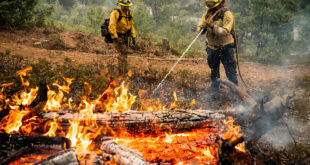It is, at the very same time, almost impossibly beautiful– and almost always teeming with people.
For Yosemite park ranger Scott Gediman… the draw of Yosemite can be both a blessing and a curse.
"Yosemite, we get four million visitors a year, which is great. But the visitors certainly impact the park," Gediman says.
That impact is seen all over, like on the banks of the Merced River that gives life to the valley.
Gediman says people rarely mean to do harm, but it happens nonetheless.
"The cumulative impact of literally thousands of people in the river basically erode away the soil and you see a lot of exposed roots," Gediman says.
Signs now ask visitors to stay out of certain areas.
People in the Lower Pines Campground can now only enter the water from very specific areas.
Same goes for meadows, where hikers stay on boardwalks to protect native plants and animals.
This sort of caution is somewhat new to Yosemite, but Gediman says it’s working.
"You’d look down, and you’d see what we call social trails," Gediman remembers. "Just zigzags of trails– people walking all over them. But now with the boardwalks, you climb up and only see the meadow."
But foot traffic is by no means the biggest traffic complaint.
Yosemite Valley roads all too often look more like parking lots, and it’s tough to look up and admire the view when you’re looking at brake lights.
"We’re trying to mitigate that by centralizing parking areas-people park," says Gediman. "We have the shuttle bus system. It’s free. It’s convenient. People get on board and it takes them to where they want to go."
Gediman says the shuttle system is already the fifth busiest shuttle system in the United States. And it’s expanding.
Yet Yosemite’s largest restoration project ever will soon begin far outside the Valley.
It will take place in the park’s Mariposa Grove of giant sequoias just inside the south entrance on Highway 41.
$ 36 million dollars will be spent to move a parking lot, gift shop and tram road away from the grove itself.
"I call it an ‘un-development project’," Gediman says.
Visitors will now park in a new lot farther away, and will be taken to the trees by– you guessed it– shuttles.
"We want the experience to be more natural, meaning you get to the sequoias and it’s the sequoias, these majestic trees."
The project will close Mariposa Grove for at least a year. A price to pay, but like all the other measures, Gediman says the inconvenience is well worth it.
"You can look at Yosemite videos, and see it on TV, but there’s no substitute for being here and feeling it," he says.
That goes for future generations. After all, the last thing we want is our grandkids’ grandkids thinking Yosemite is just a chapter in a history book.
 Mariposa Fire Mountain Community Fire Information
Mariposa Fire Mountain Community Fire Information

Wanna Comment?